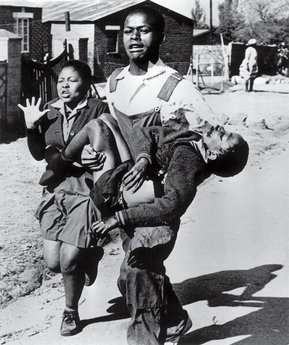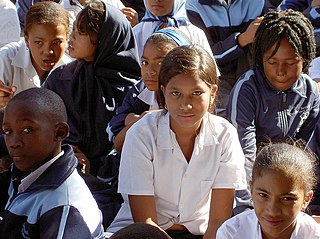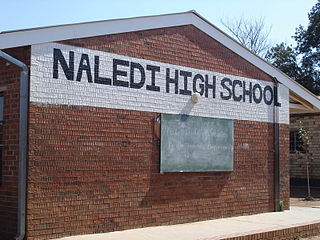
Soweto is a township of the City of Johannesburg Metropolitan Municipality in Gauteng, South Africa, bordering the city's mining belt in the south. Its name is an English syllabic abbreviation for South Western Townships. Formerly a separate municipality, it is now incorporated in the City of Johannesburg Metropolitan Municipality and is one of the suburbs of Johannesburg.

Zolile Hector Pieterson was a South African schoolboy who was shot and killed at the age of 12 during the Soweto uprising in 1976, when the police opened fire on black students protesting the enforcement of teaching in Afrikaans, mostly spoken by the white and coloured population in South Africa, as the medium of instruction for all school subjects. The students wanted to learn in their native languages, Xhosa and Zulu. A news photograph by Sam Nzima of the mortally wounded Pieterson being carried by another Soweto resident while his sister ran next to them was published around the world. The anniversary of his death is the designated Youth Day in South Africa.

The Soweto uprising, also known as the Soweto riots, was a series of demonstrations and protests led by black school children in South Africa during apartheid that began on the morning of 16 June 1976.

Education in South Africa is governed by two national departments, namely the Department of Basic Education (DBE), which is responsible for primary and secondary schools, and the Department of Higher Education and Training (DHET), which is responsible for tertiary education and vocational training. Prior to 2009, both departments were represented in a single Department of Education. Among sub-Saharan African countries, South Africa has one of the highest literacy rates. According to The World Factbook - Central Intelligence Agency as of 2019, 95% of the population aged from 15 and over can read and write in South Africa were respectively literate.
Popo Simon Molefe OLS is a businessman and former politician from South Africa.

Grace Naledi Mandisa Pandor is a South African politician, educator and academic who served as the Minister of International Relations and Cooperation until 2024. She also served as a Member of Parliament (MP) for the African National Congress (ANC) from 1994 to 2024.

Ernest Bevin Academy is a secondary school for boys and a mixed sixth form located in Tooting, London, England. The school is all-boys for ages 11 through 18, and has a co-educational sixth form. It has about 900 pupils. The school was judged as 'requiring improvement' in a November 2018 report by Ofsted. The school was judged as "Good" in a June 2022 report by Ofsted.

Alexander Sinton Secondary School, also known as Alexander Sinton High School, is an English-medium school in Athlone, a suburb of Cape Town, South Africa. The school is located in the Cape Flats, an area designated as non-white under the Group Areas Act during apartheid. The school was involved in the anti-apartheid student uprisings of the 1970s and 1980s. Staff and students at the school made headlines when they barricaded the police into their school in September 1985. The following month, three youths were killed near the school by police officers who opened fire on protesters in the Trojan Horse Incident. It was the first school to be visited by Nelson Mandela after his release from prison. As of 2014, the school has 1,100 pupils, half boys and half girls. The school employs 40 teachers and six non-teaching staff.
Teboho "Tsietsi" MacDonald Mashinini born in Jabavu, Soweto, South Africa, died in the summer of 1990 in Conakry, Guinea, and buried in Avalon Cemetery, was the main student leader of the Soweto Uprising that began in Soweto and spread across South Africa in June, 1976.

Internal resistance to apartheid in South Africa originated from several independent sectors of South African society and took forms ranging from social movements and passive resistance to guerrilla warfare. Mass action against the ruling National Party (NP) government, coupled with South Africa's growing international isolation and economic sanctions, were instrumental in leading to negotiations to end apartheid, which began formally in 1990 and ended with South Africa's first multiracial elections under a universal franchise in 1994.

Sarafina! is a 1992 musical drama film based on Mbongeni Ngema's 1987 musical of the same name. The film was directed by Darrell Roodt and written by Ngema Mbongeni and William Nicholson, and stars Leleti Khumalo, Miriam Makeba, John Kani, Ngema, and Whoopi Goldberg; Khumalo reprises her role from the stage performance.
Zola is a section of the Soweto township lying south of Johannesburg in Gauteng, South Africa. A number of well-known public figures, mostly musicians call Zola their home and were born and bred there.

Regina Mundi, designed by architect Anthony Noel Errol Slaven, is the largest Roman Catholic church in South Africa. It is located in Rockville, Soweto, a populous black urban residential area within the city of Johannesburg. Due to the role it played as a place of gathering for the people of Soweto in the years before, during, and after the anti-apartheid struggle, it is often referred to as "the people's church" or "the people's cathedral".

Temba Maqubela is a South African educator and administrator. He is the eighth and current headmaster of Groton School, the American boarding school, serving since 2013. Before Groton, he spent 26 years at Phillips Academy (Andover), eventually rising to faculty dean and assistant head of school for academics.

Naledi High School is a government secondary school at 892 Nape Street in Soweto. The school took an important role at the start of the Soweto Uprising in 1976.

Morris Isaacson High School is a government secondary school in Soweto. Founded in 1956, the school took an important role at the start of the Soweto Uprising in 1976.
Thutolore Secondary School is a government secondary school on Madubane Street in Soweto, Johannesburg.
"Soweto Blues" is a protest song written by Hugh Masekela and performed by Miriam Makeba. The song is about the Soweto uprising that occurred in 1976, following the decision by the apartheid government of South Africa to make Afrikaans a medium of instruction at school. The uprising was forcefully put down by the police, leading to the death of between 176 and 700 people. The song was released in 1977 as part of Masekela's album You Told Your Mama Not to Worry. The song became a staple at Makeba's live concerts, and is considered a notable example of music in the movement against apartheid.
The Solomon Mahlangu Freedom College (SOMAFCO), was an educational institution established by the exiled African National Congress (ANC) in 1978 at Mazimbu, Tanzania. It provided primary and secondary education to students who had fled South Africa after the 1976 Soweto uprising or who were the children of existing exiles. It taught both academic and vocational subjects, unlike the Bantu education system that hosted black students in South Africa. Farmlands supplied food to the institution and it also included a hospital. It was officially opened by Oliver Tambo in 1985.
Thamsanqa Kambule was a South African Mathematician and Educator. He was the first black professor at the University of the Witwatersrand, and was the first black person to be awarded honorary membership to the Actuarial Society of South Africa. He was awarded the Order of the Baobab in 2002 for his services to mathematics education.













